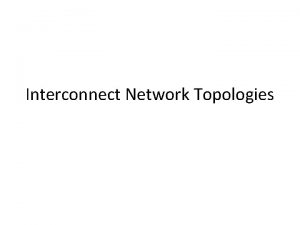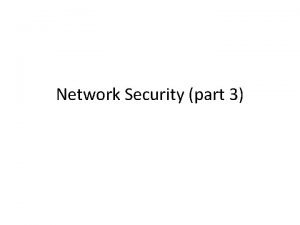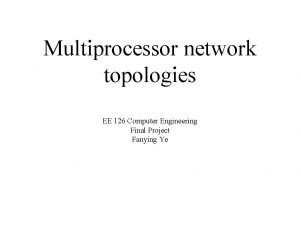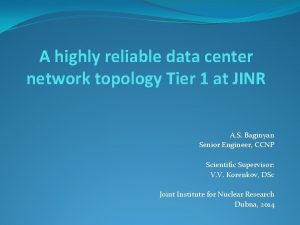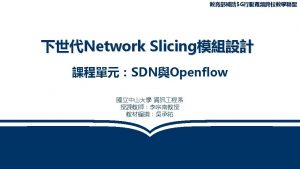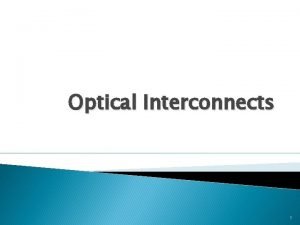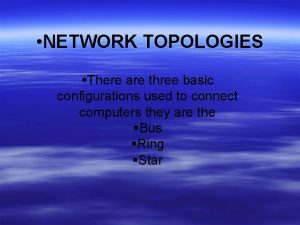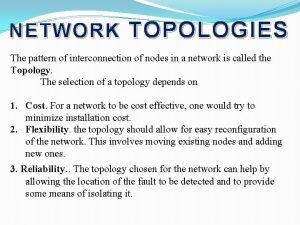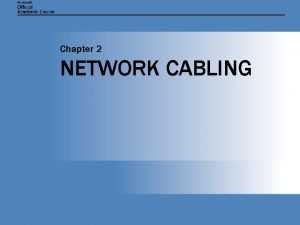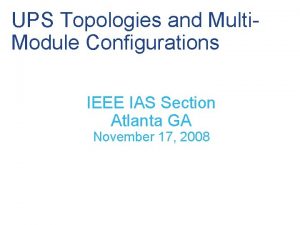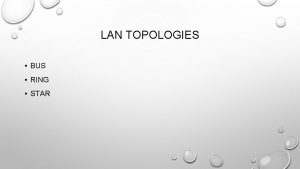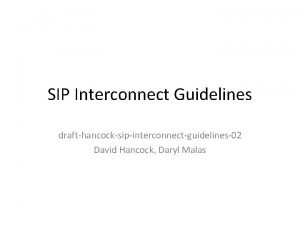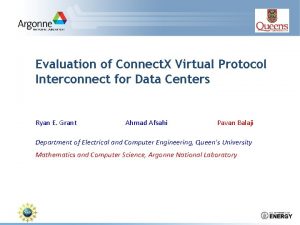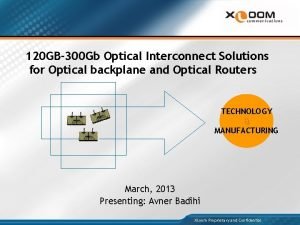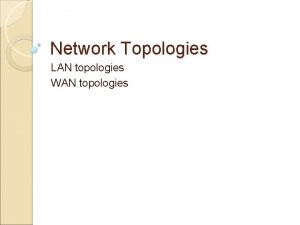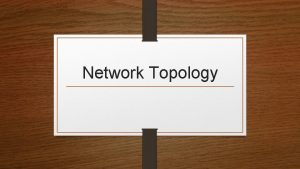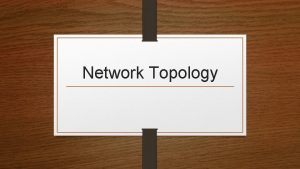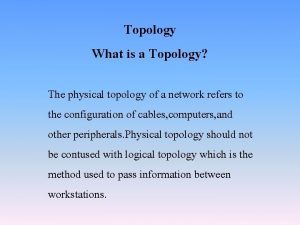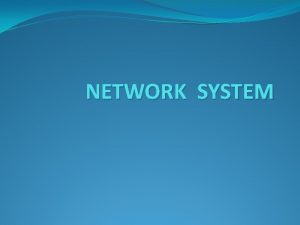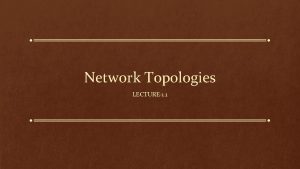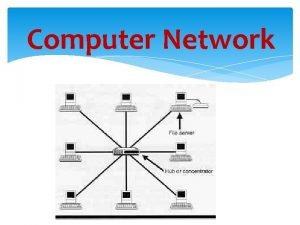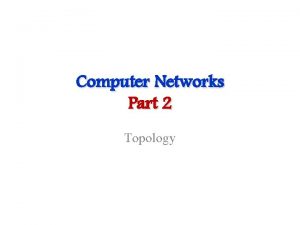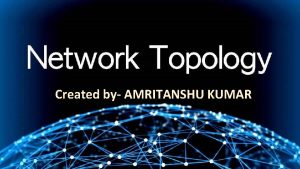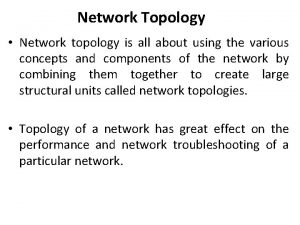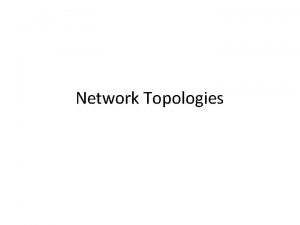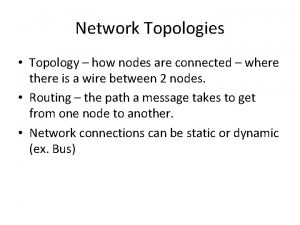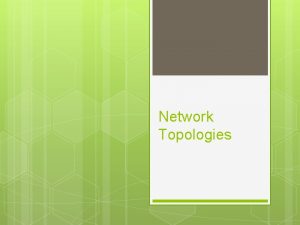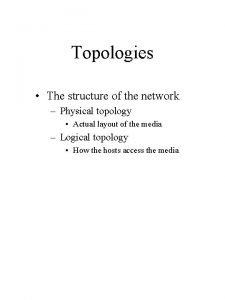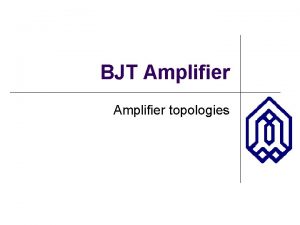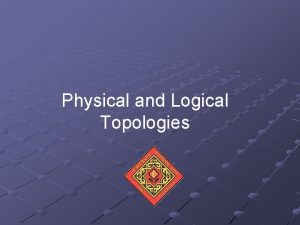Interconnect Network Topologies Characteristics of a network Topology























- Slides: 23

Interconnect Network Topologies

Characteristics of a network • Topology (what) – Physical interconnection structure of the network graph. – Physically limits the performance of the networks. • Routing algorithm (which) – Restricts the set of paths that messages can follow. • Switching strategy (how) – How data in a message traverses a route (passing routers) • Flow control mechanism (when) – When a message or portions of it traverse a route – What happens when traffic encountered

Topology • How the components are connected. • Important properties • Diameter: maximum distance between any two nodes in the network (hop count, or # of links). • Nodal degree: how many links connect to each node. • Bisection bandwidth: The smallest bandwidth between half of the nodes to another half of the nodes. • A good topology: small diameter, small nodal degree, large bisection bandwidth.

Topology • Regular topologies – Nodes are connected with some kind of patterns. • The graph has a structure. – Nodes are identified by coordinates. – Routing can usually pre-determined by the coordinates of the nodes. • Irregular topologies – Nodes are connected arbitrarily. • The graph does not have a structure, e. g. internet • More extensible in comparison to regular topology. – Usually use variations of shortest path routing.

Linear Arrays and Rings Linear array Ring (torus) Short wire torus Diameter = ? , nodal = ? Bisection bandwidth = ?

Describing linear array and ring • Array: nodes are numbered from 0, 1, …, N-1 – Node i is connected to node i+1, 0<=i<=N-2 • Ring: nodes are numbered from 0, 1, …, N-1 – Node I is connected to node (i+1) mod N, for all 0<=i<=N-1

Multidimensional Meshes and Tori • d-dimensional array/torus • N = k_{d-1} x k_{d-2} x … x k_0 • Each node is described by a d-vector of coordinate • Node (i_{d-1} x i_{d-2} x …x d_0) is connected to ? ? ?

More about multi-dimensional mesh and tori • d-dimension k-ary mesh (torus) – Each node is described by a d-vector of coordinates. • The value of each item in the vector is between 0 and d_i-1. – Diameter = ? – Nodal degree = ? – Bisection bandwidth = ?

Hypercubes • Also call binary n-cubes. # of nodes = N = 2^n • Each node is described by its binary representation. • There is a link between two nodes whose binary representations differ by one bit. • Diameter=? Nodal degree = ? Bisection bandwidth = ?

K-ary n-cube (n-dimensional, k-ary mesh/torus) • Extended from binary (hypercube) to k-ary • Each dimension has k elements, n dimensions • Each node is identified by a k-based number (n digits). – Dimension order routing 4 -ary 0 -cube 4 -ary 1 -cube 4 -ary 2 -cube 4 -ary 3 -cube

Trees • Fixed degree, log(N) diameter, O(1) bisection bandwidth. • Routing: up to the common ancestor than go down.

Irregular topology • Irregular topology does not any special mathmetic properties – Can be expanded in any way. – No easy way for routing: routes need to be computed like in the Internet. • Routes can usually be determined in a regular network by using the coordinates of the source and destination.

Direct and indirect networks • All the previously discussed networks are direct networks in that the compute nodes are directly attached to the nodes in the topology. – An example mesh system. Each switch is a 5 x 5 switch

Indirect networks • Compute nodes are not directly attached to each switch, but are rather attached to the whole network. – Using a central interconnect to connect all compute nodes – The network emulate the cross-bar switch functionality.

Fully connected network • Different organizations: – Connected by one switch (crossbar switch), connecting all nodes, connected with a crossbar. • All permutation communication (each node sends one message and receives one message) can be realized.

Multistage interconnection networks (MIN) • Try to emulate the cross-bar connection. – Realizing permutation without blocking – Using smaller cross-bar(2 x 2, 4 x 4) switches as the building block. Usually O(Nlg(N)) switches (lg(N) stages.

Multi-stage networks examples (a) An 8 -input butterfly network (b) An 8 -input Benes network • MINs can be blocking or non-blocking – Blocking: there exist some permutation that results in link contention. – Non-blocking: any permutation can be realized without link contention • Butterfly network is blocking. • Benes network is non-blocking.

Clos Network • Three stages: ingress stage, middle stage, and egress stage – Ingress/egress stage has r n X m switches – Middle stage has m r X r switches – Each switch at ingress/egress stage connects to all m middle switches (one port to each switch).

Clos Network • Clos network is nonblocking when m>=2 n-1.

Fat-Trees • Fatter links (really more of them) as you go up, so bisection BW scales with N – Not practical, root is an Nx. N switch

Practical Fat-trees • Use smaller switches to approximate large switches. – Connectivity is reduced, but the topology is not implementable – Most commodity large clusters use this topology. Also call constant bisection bandwidth network (CBB)

Clos network and fat-tree (folded Clos) A generic 2 -level fat-tree (folded Clos) A generic 3 -stage Clos network

Physical constraint on topologies • Number of dimensions. – 2 or 3 dimensions • Can be layout physically • Short wires, easy to build • Many hops, low bisection bandwidth – >=4 dimensions • Harder to build, longer wires • Fewer hops, better bisection bandwidth – K-ary n-cubes provide a good framework for comparison.
 Clos network topology
Clos network topology Whats my ip
Whats my ip Network topology ppt download
Network topology ppt download Network security topologies
Network security topologies Multiprocessor network topologies
Multiprocessor network topologies Highly reliable topology
Highly reliable topology Three dumb routers
Three dumb routers Network topologies and layout
Network topologies and layout Network physical topologies
Network physical topologies Topology in computer
Topology in computer Three basic network topologies
Three basic network topologies Wlan topology
Wlan topology What is a physical network topology
What is a physical network topology Advantages bus topology
Advantages bus topology Utp cable
Utp cable Ups topologies
Ups topologies Jupiter rising google
Jupiter rising google Amount of feedback
Amount of feedback Bjt topologies
Bjt topologies Bus, ring and star topologies mostly used in the
Bus, ring and star topologies mostly used in the Sip interconnect
Sip interconnect Virtual protocol interconnect
Virtual protocol interconnect Optical interconnect
Optical interconnect Optical interconnect solutions
Optical interconnect solutions
